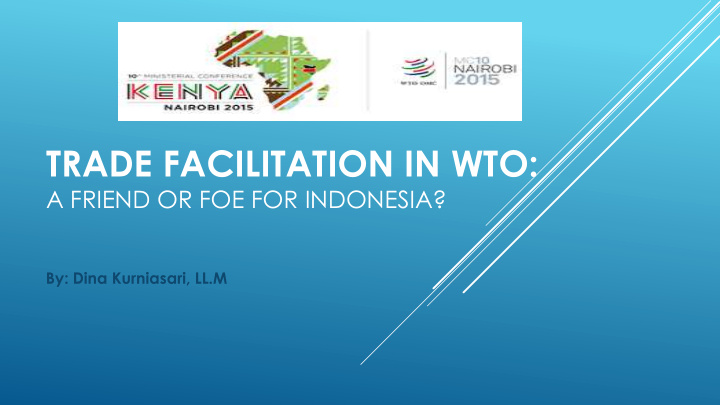



TRADE FACILITATION IN WTO: A FRIEND OR FOE FOR INDONESIA? By: Dina Kurniasari, LL.M
THE OUTLINE The Background The TFA The Current Progress TFA in Indonesia’s perspective The Challenges The Way forward
THE E BACKGROUND GROUND AND D THE E CURRENT RRENT PR PROGRESS OGRESS Trade facilitation discussed at the WTO since the Singapore Ministerial 1. Conference in December 1996 The Negotiations began in July 2004, on the basis of modalities 2. contained in Annex D of the so-called “July package” . Under this mandate, members are directed to clarify and improve GATT Article V (Freedom of Transit), Article VIII (Fees and Formalities connected with Importation and Exportation), and Article X (Publication and Administration of Trade Regulations) The final text of TFA agreed by members at the Bali Ministerial 3. Conference in Dec. 2013 and has become the first multilateral trade agreement signed since the establishment of the WTO in 1994 The work now primarily takes place in the Preparatory Committee on 4. Trade Facilitation. The Committee, which is open to all WTO members, is mandated under the Bali Ministerial Decision to ensure the expeditious e.i.f of he Agreement and to prepare for the efficient operation of the 3 Agreement upon its entry into force. ”
THE E TRADE DE FACILIT CILITATION TION AGR GREE EEMENT MENT (TFA) The TFA’s main purpose is to ease customs procedures and facilitate the movement, release and clearance of goods. The TFA is expected to cut bureaucracy and corruption in customs procedures and consequently speed up trade and lower the cost of international trade. Section I: provisions for expediting the movement, release and clearance of goods, goods in transit and customs cooperation. It improves the relevant articles (V, VIII and X) of GATT 1994. Section II: special and differential treatment (SDT) provisions that allow developing and LDCs to determine when they will implement individual provisions of the Agreement and to identify provisions that they will only be able to implement upon the receipt of technical assistance and support for capacity building. To benefit from SDT, a member must categorize each provision of the Agreement, as defined below, and notify other WTO members of these categorizations in accordance with specific timelines outlined in the Agreement: Cat. A: implemented by the time the Agreement e.i.f (or in the case of a LDC member within 1 year after e.i.f ) Cat. B: implemented after a transitional period following the e.i.f of the TFA Cat. C: implement on a date after a transitional period following the e.i.f of the TFA and requiringthe acquisition of assistance and support for capacity building. Note: the member must provide dates for implementation of the provisions for cat. B and cat. C: Section III contains provisions that establish a permanent committee on trade facilitation at the WTO, require 4 members to have a national committee to facilitate domestic coordination and implementation of the provisions of the Agreement. It also sets out a few final provisions.
THE CURRENT RENT PROG OGRESS RESS It would require around 107 out of 161 WTO members to ratify the TFA. 1. As of September 2015, only 17 members have ratified the Agreement, 2. including ASEAN members Malaysia and Singapore. 5
TFA IN INDONESIA’S PERSPECTIVE As part of Indonesia’s obligations, on July 31, 2014, Indonesia notified the Preparatory Committee on TF that only three provisions could be categorised into Category A (penalty disciplines, pre-arrival processing, and the use of Customs Brokers) However, Indonesia has not yet ratified the Agreement until now. There is a long debate during the internal consultation with related agencies on the ratification process of the TFA Considering the upcoming WTO MC10 will be held in Nairobi Next week, the question is whether the Indonesian government WILL ratify the Agreement or not? 6
THE CHALLENGES LLENGES Unless, Indonesia is able to influence other members not to ratify, the 1. insertion of the Agreement into the WTO Agreement is only a matter of time. With this in mind, to ratify or not to ratify is no longer the question. Once two-thirds of the Members have ratified, the Agreement will be automatically adopted, whether Indonesia ratifies the Agreement or not. What should Indonesia do to prepare itself? What efforts should be 2. made to take advantage of any opportunities following from the Agreement? 7
THE WAY FORWARD Indonesia, should take full advantage of the TFA by requesting technical assistance and support for capacity building to implement the provisions that Indonesia is not ready to implement yet. Designing a roadmap for TFA implementation is also a must. This roadmap can be used as the basis for policy recommendations. What are the targets, what should be done, when should it be done, how should it be done and which government agency should be responsible are among the important questions that should be addressed in the roadmap of Indonesia’s implementation of its obligations under the TFA. NOTE: consolidating and preparing Indonesia’s own domestic readiness is much more crucial than debating whether to ratify the WTO TFA or not.
www.kemendag.go.id 9 http://ditjenkpi.kemendag.go.id/website_kpi/
Recommend
More recommend